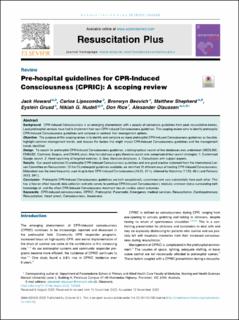| dc.description.abstract | Background CPR-Induced Consciousness is an emerging phenomenon with a paucity of consensus guidelines from peak resuscitative bodies. Local prehospital services have had to implement their own CPR-Induced Consciousness guidelines. This scoping review aims to identify prehospital CPR-Induced Consciousness guidelines and compare or contrast their management options. Objective The purpose of this scoping review is to identify and compare as many prehospital CPR-Induced Consciousness guidelines as feasible, highlight common management trends, and discuss the factors that might impact CPR-Induced Consciousness guidelines and the management trends identified. Design To search for prehospital CPR-Induced Consciousness guidelines, a bibliographical search of five databases was undertaken (MEDLINE, EMBASE, Cochrane, Scopus, and CINAHL plus). Also included was a grey literature search arm, comprised of four search strategies: 1. Customised Google search, 2. Hand searching of targeted websites, 3. Grey literature databases, 4. Consultation with subject experts. Results Our search extracted 23 prehospital CPR-Induced Consciousness guidelines and one good practise statement from the International Liaison Committee on Resuscitation. Of the 23 prehospital guidelines available, we identified 20 different ways of treating CPR-Induced Consciousness. Midazolam was the most frequently used drug to treat CPR-Induced Consciousness (14/23, 61%), followed by Ketamine (11/23, 48%) and Fentanyl (9/23, 39%). Conclusion Prehospital CPR-Induced Consciousness guidelines are both exceptionally uncommon and vary substantially from each other. This has a flow-on effect towards data collection and only serves to continue CPR-Induced Consciousness’s relatively unknown status surrounding both knowledge of, and the effect CPR-Induced Consciousness treatment has on cardiac arrest outcomes. | en_US |

